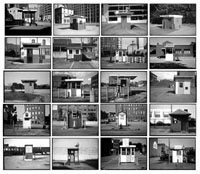
Fallaces sunt rerum species. *
Work from the archives of the
Rhode Island Photographic Survey
These photographs are drawn from my ongoing work for the Rhode Island Photographic Survey. Consistent with the mission of the survey to utilize and question the documentary aspects of the photographic medium, this work also demonstrates my specific interests. Interests which include: sites of local unimportance, simple structures, signage of all types, evidence of personal expression, and locales in all manner of flux and flow.
Our state and its environs continue to be transformed, sometimes at an alarming rate. The public realm, increasingly under corporate sponsorship in some areas, sprouts with chaotic energy and activity in others, and everywhere places are bent to the needs of the automobile. Sites of accomplishment and pride become ruins and these ruins are in turn discovered within a frontier wilderness, waiting to again be tamed and "civilized." This is the sphere of the survey.
Our colleague and friend Erik Carlson says the following about the project:
| Streets, intersections, parking lots-our environment is filled with such intermediary spaces that have been determined by the pervasiveness of our automobile-based culture. Though often ill-planned on the human scale, these spaces are designed by human necessity-the need to accommodate habit, movement, and volume-and decorated by accident, accumulation or neglect. Most thoroughfares are a jumble of sign vying for attention, a scatter of information that we pass through on the way to other spaces. Only occasionally do we stop to notice their details, generally with impatience at a red light or traffic bottleneck, shortly before reaching for the horn. Still, what separates one road from the next is the meaning we give to signs and landmarks encountered along the way. All thoroughfares are known by their intersections, social as well as spatial.
These photos reveal the living aspect of our discarded places, those sites that we see without seeing in the course of daily movement. Suddenly, in someone's backwoods riff on the urban parking shed, in the weather-worn eulogies of a roadside memorial, in the collective dialect of one's street composite of signs, we find more than we bargained for. Charismatic juxtapositions, unintended typologies, and the embellishments of eccentric personal detail reveal that these spaces are not lost in our landscape but very much a part of it. We're claimed them as our own. |
* The appearance of things are deceptive. - Lucius Annaeus Seneca | |

Every Bradford Pear Tree along Freeborn Ave., East Providence, RI, 2003 (detail: 7 of 48 panels)
The Bradford Pear Tree (Pyrus calleryana) has long been popular with urban arborists. According to Better Homes and Gardens, the tree is popular for "its uniform, oval shape and beautiful (though foul-smelling) white spring flowers" and for its ability to thrive in an automobile-centered environment. These trees seem unaffected by air pollution, and according to a city tree specialist we spoke with in Providence, "they tend to grow around wires." One other feature makes them popular with the Department of Public Works: they tend to self-destruct when they reach 20-30 feet in height. Because the mature wood is brittle and the branch angles are weak, the tree is prone to split apart in storms. They are replaced long before roots start breaking up sidewalks or they become so large that they impair a driver's visibility. These 48 trees are planted as a screen above I-195 on Freeborn Ave. in East Providence, RI.


West side of Main St. (US Route 1), East Greenwich, RI, 2003, (detail: 7 of 48 panels)
This streetscape was photographed over two consecutive mornings in late spring. This coastal town has become somehting of a center for Rhode Island bridal fashion. Within this 1 mile stretch one can find no less than a half dozen bridal shops.
 
20 Parking Shacks in Downtown Providence, RI, 2001
We've counted some 40 parking shacks within the city of Providence. Among our favorites are those that appear home built and sport colorful names such as "Early Bird" and "Park." Also interesting are the prefabricated units such as those made under the Par-Kut brand. In our experience it is best to view these shacks on foot.
Click here for a map detailing the location of each parking shack. |